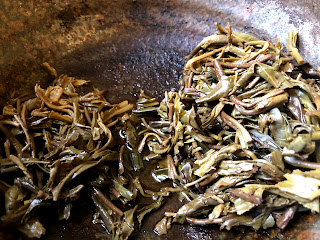For the causal puerh drinker, no find is better than a puerh
which you enjoy to drink which has been discounted due to some wrapper or other
cosmetic issue. Marshal’N beamed about
this in one of his comments about 7542 earlier this year. I too have somewhat recently took advantage
of this discount. I ended up saving
about $15/$20 per cake on these 2015 Zheng Si Long Wa Long when it was
advertised that the batch had excessive tearing to the wrapper. This was nice considering it was on my list
of puerh to buy anyway! I suppose the
decision to offer a discount for cosmetic reasons can also be used as a bit of
a marketing technique because it is a bit of a call to action.
The reality of it is that it is just the vendors being as transparent
as possible about what they are selling so to ensure there are no
surprises. Vendors like white2tea and
Yunnan Sourcing don’t explicitly discount cakes with cosmetic damage such as
tears or bug bites or staining or excessive dust. However, you can almost be sure that they
acquired these cakes for a cheaper price and that price is being passed on to
the customer. They will state the issues
of concern as a matter of transparency on the product page such as in the
description of white2tea’s Very Old Huangpian or recently in Yunnan Sourcing's 2006 Changtai “65th Anniversary of Tong An Teahouse”.
Interestingly, I had received a different puerh order this
year from a Western vendor that I will not mention. The wrappers from this order were actually
much more ripped up than the 2015 Zheng Si Long Wa Long wrappers but were not
advertised as such! The puerh was around
the same age. I didn’t see the reason to
complain and felt silly asking for a discount because, really, I don’t
care. The one thing that both of these
puerh had was that they were not double wrapped and that they had a very thin
type of paper wrapper.
The type of wrapper, thickness, and weather it is double
wrapped makes a real difference. It also
influences how the puerh will actually age and because each type of wrapping
offers different benefits to aging, something that isn’t discussed much in the
West but is a discussion point in Asia among teamasters. It also offers the puerh cakes protection from extreme
humidity/dryness, pests, light, ect. That could damage the puerh. The
type of wrapper isn’t just a marketing thing, it’s something that can be
considered on a practical level ... but it’s never the primary consideration
when buying puerh… usually just a bonus.
In my experience drinking puerh from the 80s and 90s, there
was almost always some damage or cosmetic thing with these cakes. This is just natural and historically it was
completely normal wear and tear. Remember that
donkeys traveling the Tea Horse Road used to haul this stuff! Historically, it wasn’t kept in mint
condition so why should we expect that now?
I understand that for a collector of puerh, this thing might matter for
resale, but for the drinker it’s all superficial anyways…
Peace






















